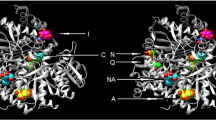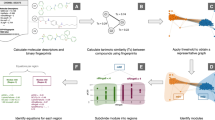Abstract
Glucokinase is an enzyme which is responsible for the conversion of glucose to glucose-6-phosphate through ATP-dependent phosphorylation and has a significant role in glycogen synthesis and hepatic glucose production. Allosteric activators of glucokinase could be an attractive approach for the treatment of T2DM (type 2 diabetes mellitus). Recently, an innovative standard “Index of Ideality of Correlation” has been introduced for the estimation of QSAR (quantitative structural activity relationship) model’s potential. In the present work, QSAR models for activators of glucokinase have been developed with target function TF1 and TF2 using index of ideality of correlation (IIC). Along with this, prediction of calibration sets for different QSAR models generated for different splits is also categorized as correct and wrong. Moreover, dispersion in the different runs of same split is also explained. The values of criteria R2 and IIC for best split prepared with target function TF1 are 0.6554 and 0.7912 and that for TF2 are 0.9531 and 0.9758, respectively. The models developed with index of ideality of correlation are better than the models generated without index of ideality of correlation. The IIC could be a better criteria option for predictability of QSAR model for glucokinase activators.



Similar content being viewed by others
References
Bebernitz GR, Beaulieu V, Dale BA, Deacon R, Duttaroy A, Gao J, Grondine MS, Gupta RC, Kakmak M, Kavana M, Kirman LC, Liang J, Maniara WM, Munshi S, Nadkarni SS, Schuster HF, Stams T, Denny IS, Taslimi PM, Vash B, Caplan SL (2009) Investigation of functionally liver selective glucokinase activators for the treatment. J Med Chem 52:6142–6152
Bonn P, Brink DM, Fägerhag J, Jurva U, Robb GR, Schnecke V, Svensson A, Waring MJ, Westerlund C (2012) The discovery of a novel series of glucokinase activators based on a pyrazolopyrimidine scaffold. Bioorg Med Chem Lett 22:7302–7305
Charaya N, Pandita D, Grewal AS, Lather V (2018) Design, synthesis and biological evaluation of novel thiazol-2-yl benzamide derivatives as glucokinase activators. Comput Biol Chem 73:221–229
Kumari V, Li C (2008) Comparative docking assessment of glucokinase interactions with its allosteric activators. Curr Chem Genomics 2:76–89
Bertram LS, Black D, Briner PH, Chatfield R, Cooke A, Fyfe MCT, Murray PJ, Rasamison CM, Reynet C, Schofield KL, Shah VK, Spindler F, Taylor A, Turton R, Williams GM, Wong-kai-in P, Yasuda K (2008) Pharmacokinetics, safety and efficacy of glucokinase activating 2-(4-sulfonylphenyl)-N-thiazol-2-ylacetamides : discovery of PSN-GK1. J Med Chem 51:4340–4345
Antoine M, Boutin JA, Ferry G (2009) Binding kinetics of glucose and allosteric activators to human glucokinase reveal multiple conformational states. Biochemistry 48:5466–5482
Bowler JM, Hervert KL, Kearley ML, Miller BG (2013) Small-molecule allosteric activation of human glucokinase in the absence of glucose. ACS Med Chem Lett 4:580–584
Begum S, Achary PGR (2015) Simplified molecular input line entry system-based: QSAR modeling for MAP kinase-interacting protein kinase (MNK1). SAR QSAR Environ Res 26(5):343–361
Begam BF, Kumar JS (2016) Computer assisted QSAR / QSPR approaches – a review. Ind J Sci Tech 9(8). https://doi.org/10.17485/ijst/2016/v9i8/87901
Toropov AA, Toropova AP (2017) The index of ideality of correlation: a criterion of predictive potential of QSPR / QSAR models ? Mutat Res Gen Tox En 819:31–37
Park K, Lee BM, Kim YH, Han T, Yi W, Lee DH, Choi HH, Chong W, Lee CH (2013) Discovery of a novel phenylethyl benzamide glucokinase activator for the treatment of type 2 diabetes mellitus. Bioorg Med Chem Lett 23:537–542
Park K, Lee BM, Hyun KH, Lee DH, Choi HH, Kim H, Chong W, Kim KB, Nam SY (2014) Discovery of 3-(4-methanesulfonylphenoxy)-N-[1-(2-methoxyethoxymethyl)-1H-pyrazol-3-yl]-5-(3-methylpyridin-2-yl)-benzamideas a novel glucokinase activator (GKA) for the treatment of type 2 diabetes mellitus. Bioorg Med Chem 22:2280–2293
Park K, Lee BM, Hyun KH, Han T, Lee DH (2015) Design and synthesis of acetylenyl benzamide derivatives as novel glucokinase activators for the treatment of T2DM. ACS Med Chem Lett 6:296–301
Toropova AP, Toropov AA, Veselinovic JB, Miljkovi FN, Veselinovic AM (2014) QSAR models for HEPT derivates as NNRTI inhibitors based on Monte Carlo method. Eur J Med Chem 77:298–305
Marvin Sketch v.14.11.17.0, (2014) ChemAxon, XhemAxon KFT. Budapest, Hungary
O’Boyle N, Banck M, James CA, Morley C, Vandermeersch T, Hutchison GR (2011) Open babel: an open chemical toolbox. J.Cheminform. 3:33
Kumar P, Kumar A, Sindhu J, Lal S (2019) QSAR models for nitrogen containing monophosphonate and bisphosphonate derivatives as human farnesyl pyrophosphate synthase inhibitors based on Monte Carlo method. Drug Res 69:159–167
Toropova AP, Toropov AA (2017) The index of ideality of correlation: a criterion of predictability of QSAR models for skin permeability ? Sci Total Environ 586:466–472
OECD principles for the validation, for regulatory purposes, of (quantitative) structure-activity relationship models. Available at:http://www.oecd.org/chemicalsafety/risk-assessment/37849783.pdf
Kumar A, Chauhan S (2016) Use of the Monte Carlo method for OECD principles-guided QSAR modeling of SIRT1 inhibitors. Arch Pharm Chem Life Sci 349:1–9
Zivkovic JV, Truti NV, Veselinovic JB, Nikoli GM, Veselinovic AM (2015) Monte Carlo method based QSAR modeling of maleimide derivatives as glycogen synthase kinase-3 β inhibitors. Comp Biol Med. https://doi.org/10.1016/j.compbiomed.2015.07.004
Kumar A, Chauhan S (2016) QSAR differential model for prediction of SIRT1 modulation using Monte Carlo method. Drug Res 67(3):156–162
Sokolović D, Aleksić D, Milenković V, Karaleić S, Mitić D, Kocić J, Mekić B, Veselinović JB, Veselinović AM (2016) QSAR modeling of bis-quinolinium and bis-isoquinolinium compounds as acetylcholine esterase inhibitors based on the Monte Carlo method–the implication for myasthenia gravis treatment. Med Chem Res 25:2989–2998
Manisha, Chauhan S, Kumar P, Kumar A (2019) Development of prediction model for fructose-1,6-bisphosphatase inhibitors using the Monte Carlo method. SAR QSAR Environ Res 30:145–159
Kumar A, Chauhan S (2018) Use of simplified molecular input line entry system and molecular graph based descriptors in prediction and design of pancreatic lipase inhibitors. Future Med Chem 10:1603–1622
Kumar P, Kumar A (2017) Monte Carlo method based QSAR studies of Mer kinase inhibitors in compliance with OECD principles. Drug Res 68(04):189–195
Toropov AA, Carbó-dorca R, Toropova AP (2017) Index of ideality of correlation : new possibilities to validate QSAR : a case study. Struct Chem 29(1):33–38
Toropov AA, Toropova AP (2018) Use of index of ideality of correlation to improve predictive potential for biochemical endpoints. Toxicol Mech Methods. https://doi.org/10.1080/15376516.2018.1506851
Toropova AP, Toropov AA (2019) Does the index of ideality of correlation detect the better model correctly ? Mol Inf. https://doi.org/10.1002/minf.201800157
Toropova AP, Toropov AA (2018) The index of ideality of correlation : improvement of models for toxicity to algae of models for toxicity to algae. Nat Prod Res. https://doi.org/10.1080/14786419.2018.1493591
Toropova AP (2018) The index of ideality of correlation : hierarchy of Monte Carlo models for glass transition temperatures of polymers. J Polym Res. https://doi.org/10.1007/s10965-018-1618-z
Gaikwad R, Ghorai S, Amin SA, Adhikari N, Patel T, Das K, Jha T, Gayen S (2018) Monte Carlo based modelling approach for designing and predicting cytotoxicity of 2-phenylindole derivatives against breast cancer cell line MCF7. Toxicol Vitr 52:23–32
Rescifina A, Floresta G, Marrazzo A, Parenti C, Prezzavento O, Nastasi G, Amata E, Dichiara M, Amata E (2017) Development of a sigma-2 receptor affinity filter through a Monte Carlo based QSAR analysis. Eur J Pharm Sci 106:94–101
Acknowledgments
The authors are highly indebted to Dr. Andrey A. Toropov and Dr. Alla P. Toropova for providing the CORAL.
Author information
Authors and Affiliations
Corresponding author
Ethics declarations
Conflict of interest
The authors declare that they have no conflict(s) of interest.
Additional information
Publisher’s note
Springer Nature remains neutral with regard to jurisdictional claims in published maps and institutional affiliations.
Electronic supplementary material
ESM 1
(DOCX 26 kb)
Rights and permissions
About this article
Cite this article
Nimbhal, M., Bagri, K., Kumar, P. et al. The index of ideality of correlation: A statistical yardstick for better QSAR modeling of glucokinase activators. Struct Chem 31, 831–839 (2020). https://doi.org/10.1007/s11224-019-01468-w
Received:
Accepted:
Published:
Issue Date:
DOI: https://doi.org/10.1007/s11224-019-01468-w




